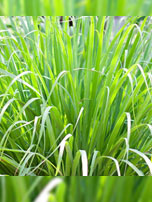SHAHEED KARTAR SINGH SARABHA AYURVEDIC MEDICAL COLLEGE & HOSPITAL
Affiliated to Guru Ravidas Ayurved University, Hoshiarpur Punjab
Affiliated to Guru Ravidas Ayurved University, Hoshiarpur Punjab

Botanical Name : Cymbopogon Citratus Stapf.
Family : Poaceae
Background :
The plant Cymbopogon citratus Stapf. commonly known as Lemon grass belongs to Poeceae family and is a native of tropical countries, especially in Southeast Asia. Various studies has been done on the plant to reveal its potential therapeutic effects.
Names in different Indian languages :
English: West Indian lemon grass, true lemon grass
Morphology :
Cymbopogon citratus is part of the grass family, Poaceae. They contain simple, bluish-green leaves with entire margins and are linear in shape. The blades tend to be 18–36 inches long. Like other grasses, the leaves also have parallel venation.
Distribution :
Cymbopogon citratus is native to Island Southeast Asia (Malesia). It has been introduced extensively to South Asia since precolonial times. After the World War I, lemongrass was introduced to Madagascar, South America, and Central America. It has now been naturalized throughout the tropics and subtropics worldwide.
In its native range, Cymbopogon citratus is known as sereh, serai, or serai dapur in Indonesia and Malaysia; and tanglad, salai, or balioko in the Philippines.
Culinary Uses :
Cymbopogon citratus is abundant in the Philippines and Indonesia where it is known as tanglad or sereh. Its fragrant leaves are traditionally used in cooking, particularly for lechon and roasted chicken.
The dried leaves can also be brewed into a tea, either alone or as a flavoring in other teas, imparting a flavor reminiscent of lemon juice but with a mild sweetness without significant sourness or tartness.
In Sri Lanka, lemongrass is known as sera. It is used as a herb in cooking, in addition to its use for the essential oils.
Lemongrass in Thailand is called takhrai. It is the essential ingredient of tom yam and tom kha kai. Fresh thin slices of lemongrass stem also used in miangpla, as a snack food.
Medicinal Uses :
The leaves of Cymbopogon citratus have been used in traditional medicine and are often found in herbal supplements and teas.
Chemical composition :
Lemon grass oil contains 65–85% citral in addition to myrcene, citronellal, citronellol, and geraniol. Hydrosteam distillation, condensation, and cooling can be used to separate the oil from the water. The hydrosol, as a by-product of the distillation process, is used for the production of skin care products such as lotions, creams, and facial cleansers. The main ingredients in these products are lemon grass oil and “negros oil” (mixture of lemon grass oil with virgin coconut oil) used in aromatherapy.
Citronellol is an essential oil constituent from Cymbopogon citratus, Cymbopogon winterianus, and Lippia alba. Citronellol has been shown to lower blood pressure in rats by a direct effect on the vascular smooth muscle leading to vasodilation. In a small, randomized, controlled trial, an infusion made from C. citratus was used as an inexpensive remedy for the treatment of oral thrush in HIV/AIDS patients.
Laboratory studies have shown cytoprotective, antioxidant, and anti-inflammatory properties in vitro.
Traditional medicinal use :
In the folk medicine of the Krahô people of Brazil, it is believed to have anxiolytic, hypnotic, and anticonvulsant properties.
In traditional medicine of India the leaves of the plant are used as stimulant, sudorific, antiperiodic, and anticatarrhal, while the essential oil is used as carminative, depressant, analgesic, antipyretic, antibacterial, and antifungal agent.
Effect on insects :
Video tracking of a stable fly, demonstrating repellency of lemongrass oil.
Beekeepers sometimes use lemon grass oil in swarm traps to attract swarms. Lemon grass oil has also been tested for its ability to repel the pestilent stable fly, which bite domestic animals.
